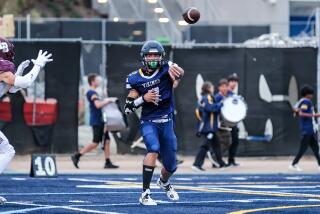Assessing the Foul and Fair of Open Enrollment
- Share via
La Quinta High has maintained its status as an Orange County baseball power in recent years by attracting top players, many of whom live outside the school’s attendance boundaries.
Coach Dave Demarest says the influx of out-of-area players transferring to La Quinta--perfectly legal under district open enrollment rules--only reflects their desire to join a stable, winning program that boasts 16 league titles and two Southern Section championships under his leadership.
Others have a different view. La Quinta critics say the defections are the result of recruiting efforts that create an uneven playing field in the Garden Grove League. They contend that this pre-enrollment contact reveals a sordid side of high school sports that the California Interscholastic Federation has struggled to address through vague undue influence rules.
“We’re losing all these kids,” says Pacifica Coach Mark Flatten, who has seen five Pacifica players transfer to La Quinta in the last two years, “and I wouldn’t say it goes under the heading of ‘illegal,’ but it definitely goes under the heading of ‘not very nice.’ ”
A proposal being developed by the CIF would curb the kind of alleged pre-enrollment contact that Flatten and other Garden Grove League coaches, players and parents say has occurred since open enrollment was instituted beginning with the 1994-95 school year.
The proposal, which will top the agenda when the CIF council reconvenes in the fall, would force school officials to certify that no one connected with their athletic departments or booster clubs made contact with prospective transfers regarding athletic teams.
But some question whether the proposal would crack down on certain instances of contact--players on one team talking to players on another, to name one--that critics say contribute to the number of top players who transfer.
Flatten said the proposal would only serve to “make everybody feel a little bit better. What is signing a paper going to do? It’s just a formality. It’s not going to change anything.”
The proposal was prompted by several incidents in which foreign basketball players were brought to high school programs by intermediaries. But it intends to have a much broader impact, preventing teams in all sports from being stacked with recruited athletes.
The challenge is creating legislation that is flexible enough to address the nuances of individual cases, said Southern Section Commissioner Jim Staunton, a member of the committee that is forming the proposal. “Each case is individual,” he said. “It’s really hard to apply a broad brush to this at this point.”
State council members have already voiced concerns as to what exactly would constitute pre-enrollment contact. Can mothers of athletes at different schools have a conversation about sports teams at the grocery store? Can a volleyball player at one school call his friend at another school and try to convince him to switch teams?
Southern Section Assistant Commissioner Rob Wigod said it is especially difficult to gauge whether communication between players amounts to undue influence.
“If a kid on his own is doing this, it’s hard,” he said. “We would be more concerned if [players] were directed to talk.”
Rancho Alamitos senior catcher Frank De La Rosa said he was contacted by at least three La Quinta players--only one of whom he knew--in May 2000 during the Vaqueros’ final regular-season game, against the Aztecs.
De La Rosa said the players spoke to him as they came to bat while he crouched behind the plate. They told him that “coach” really wanted him to play for the Aztecs. “They said, ‘Are you coming over here next year or what?’ ” De La Rosa said.
Demarest and La Quinta Athletic Director Jim Perry said they have never recruited players, or asked team members to do so. In the case of De La Rosa, Demarest added that his team wasn’t interested in a player at that position.
“Why would I have De La Rosa come to La Quinta when I’ve got an all-star catcher coming back?” he said. “It doesn’t make sense.”
Parents from opposing teams have also complained about what they say is recruiting. One parent said Demarest made a sales pitch--”You should bring [your son] down to La Quinta if he’s seriously considering a career in baseball,”--at a Little League all-star game a few years ago. “It’s like they’re stacking this team over there,” the parent complained.
La Quinta opponents also say they have received phone calls that they felt were part of an attempt to recruit them.
In one case, someone claiming to be a Cypress College coach urged De La Rosa to play at La Quinta if he had hopes of playing for the community college. Cypress Coach Scott Pickler said none of his coaches called the youth.
In another case, Alex Guadarrama, a senior second baseman at Bolsa Grande, said he received a call during his sophomore year from someone who said he was a La Quinta player but declined to give his name.
The caller told Guadarrama that transferring to La Quinta would provide him with a good opportunity to start for the Aztecs.
“I was kind of flattered at first,” Guadarrama said, “but then I was mad because I knew we had a chance to beat them and it was like they were trying to break up our program.”
Perry said he could not respond to allegations of anonymous calls. “What are we supposed to do?” he asked. “We do not call kids. Our coaches don’t, our parents don’t, our players don’t.”
What La Quinta has done is establish a tradition of success, winning about 75% of the time under Demarest, whose Aztec teams are 586-192 in his 28 years. La Quinta finished this season tied for first in the Orange County Sportswriters’ Poll and advanced to the quarterfinal round of the Southern Section Division IV playoffs.
This season’s 15-man roster included seven transfers, five of whom came from Pacifica: sophomore shortstop Blake Crosby, who started at Pacifica as a freshman; senior pitcher Bryan Kelley, who went from being Pacifica’s ace to the No. 3 starter at La Quinta; junior Mike McKernan, another top pitcher, and his brother Ryan, a senior catcher; and senior pitcher Fernando Pacheco, a reserve.
“We’re fighting an uphill battle outside the field,” Pacifica’s Flatten said. “We’re not losing kids to Los Alamitos or Cypress, which are both closer [geographically] with good baseball programs. They take what they got and go with it.”
Demarest said Pacifica and other league schools have lost players in recent years because of turmoil within their programs. Pacifica and Rancho Alamitos have each gone through four coaches in the last five years, Demarest pointed out. Bolsa Grande’s coach, Doug Euper, resigned last week.
“Kids don’t leave their friends and uproot to go play for Dave Demarest and La Quinta baseball,” Demarest said. “They are leaving their programs because they are unhappy.”
Rancho Alamitos assistant coach Jon Martin said his school’s principal, Gene Campbell, asked that neither he nor Coach Terry Tewell comment on the matter.
Concerns about the siphoning off of talent from other programs have been at the heart of the bad blood between Rancho Alamitos and La Quinta in recent years. Players from both teams did not engage in customary handshakes after games until principals from both schools forced them.
Students who live within the Garden Grove Unified School District are entitled to a one-time intradistrict transfer by parental choice or specified reason, such as a specialized instruction program offered by a particular high school.
Students who live outside the district use interdistrict transfers, which require a release from the district of residence and an acceptance by the district of attendance.
Perry, La Quinta’s athletic director, downplayed the number of transfers to his school, and said it has had little effect on the Aztec baseball program. He said that because of open enrollment, it is normal practice for schools within the district to accept a large number of students whose home addresses would place them elsewhere.
“Before open enrollment, from 1978-95, La Quinta was first or second in the league every year but one,” Perry said. “We had two CIF championships and were runners-up once. Things haven’t changed.”
A few league coaches, including Garden Grove’s Jim Rawls, said they have not been affected by the migration of players to La Quinta. “We don’t suffer the same type of situation,” Rawls said.
Said Santiago Coach Paul Allen: “I have never had a problem with it. . . . But I think it’s a very legitimate concern. I just wish everyone would do what they’re supposed to do and be satisfied with what [players] they have.”
More to Read
Get our high school sports newsletter
Prep Rally is devoted to the SoCal high school sports experience, bringing you scores, stories and a behind-the-scenes look at what makes prep sports so popular.
You may occasionally receive promotional content from the Los Angeles Times.







